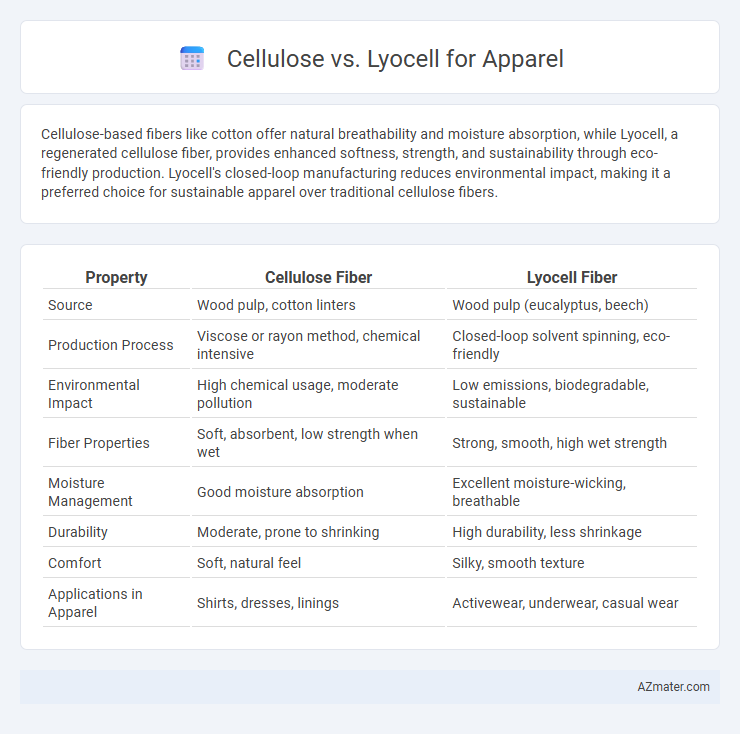Cellulose-based fibers like cotton offer natural breathability and moisture absorption, while Lyocell, a regenerated cellulose fiber, provides enhanced softness, strength, and sustainability through eco-friendly production. Lyocell's closed-loop manufacturing reduces environmental impact, making it a preferred choice for sustainable apparel over traditional cellulose fibers.
Table of Comparison
| Property | Cellulose Fiber | Lyocell Fiber |
|---|---|---|
| Source | Wood pulp, cotton linters | Wood pulp (eucalyptus, beech) |
| Production Process | Viscose or rayon method, chemical intensive | Closed-loop solvent spinning, eco-friendly |
| Environmental Impact | High chemical usage, moderate pollution | Low emissions, biodegradable, sustainable |
| Fiber Properties | Soft, absorbent, low strength when wet | Strong, smooth, high wet strength |
| Moisture Management | Good moisture absorption | Excellent moisture-wicking, breathable |
| Durability | Moderate, prone to shrinking | High durability, less shrinkage |
| Comfort | Soft, natural feel | Silky, smooth texture |
| Applications in Apparel | Shirts, dresses, linings | Activewear, underwear, casual wear |
Introduction to Cellulose and Lyocell
Cellulose is a natural polymer derived from plant cell walls, serving as the primary raw material for many sustainable textiles, including cotton and rayon. Lyocell, a type of regenerated cellulose fiber, is produced through a closed-loop process using wood pulp, offering enhanced strength, breathability, and biodegradability compared to traditional viscose. Both fibers prioritize eco-friendly production and comfort, making them popular choices in sustainable apparel manufacturing.
What is Cellulose?
Cellulose is a natural polymer derived from plant cell walls, primarily composed of glucose units, making it the most abundant organic compound on Earth. In apparel, cellulose fibers like cotton and viscose offer breathability and moisture-wicking properties, enhancing comfort and sustainability. Understanding cellulose's biodegradability and renewable nature highlights its importance in developing eco-friendly textile alternatives such as Lyocell, which uses a more sustainable production process.
What is Lyocell?
Lyocell is a sustainable fiber derived from cellulose found in wood pulp, typically sourced from eucalyptus, beech, or spruce trees. It is produced through a closed-loop process that recycles water and solvents, minimizing environmental impact compared to traditional viscose production. Known for its softness, breathability, and moisture-wicking properties, lyocell is a preferred choice in eco-friendly apparel manufacturing.
Manufacturing Process: Cellulose vs Lyocell
Cellulose fibers, derived from natural plant sources like cotton and wood pulp, undergo chemical treatments and mechanical processing to produce materials such as viscose or rayon. Lyocell, a type of regenerated cellulose fiber, utilizes an eco-friendly manufacturing process involving dissolving wood pulp in a non-toxic amine oxide solvent with a closed-loop system that recycles water and solvents efficiently. This sustainable approach makes Lyocell production less harmful compared to traditional cellulose fiber methods, reducing environmental impact in apparel manufacturing.
Environmental Impact Comparison
Cellulose fibers like cotton and rayon are traditionally used in apparel but often require significant water, pesticides, and energy resources, contributing to environmental strain. Lyocell, derived from sustainably sourced wood pulp and produced through a closed-loop solvent spinning process, offers a lower environmental footprint by minimizing water use and chemical waste. Its biodegradability and efficient manufacturing position Lyocell as an eco-friendlier alternative in sustainable fashion compared to conventional cellulose fibers.
Comfort and Breathability for Apparel
Lyocell fibers, derived from sustainable wood pulp through a closed-loop solvent spinning process, offer superior moisture-wicking and softness compared to traditional cellulose-based fibers like cotton or viscose, enhancing comfort in apparel. The smooth surface and high absorbency of Lyocell enable better air circulation and breathability, reducing heat retention and skin irritation during wear. Cellulose fibers provide natural breathability, but Lyocell's advanced fiber structure ensures enhanced temperature regulation and a silky feel, making it ideal for performance and everyday clothing.
Durability and Longevity
Lyocell fibers, derived from sustainably sourced wood pulp through a closed-loop process, exhibit superior durability compared to traditional cellulose fibers like viscose or rayon. Increased tensile strength and resistance to abrasion make Lyocell apparel ideal for long-term wear, maintaining shape and appearance over repeated washing cycles. Cellulose fibers generally show quicker degradation and pilling under stress, reducing the garment's overall lifespan.
Cost and Accessibility
Cellulose fibers like cotton and viscose typically cost less than Lyocell due to simpler production processes and widespread availability of raw materials. Lyocell, made from sustainably sourced wood pulp through a closed-loop process, commands higher prices but offers superior moisture-wicking and durability, justifying its premium cost in performance apparel. Accessibility favors cellulose fibers as they are mass-produced globally, whereas Lyocell remains limited to specialized manufacturers, impacting its market penetration despite growing demand in eco-conscious fashion.
Sustainability and Ethical Considerations
Lyocell, derived from sustainably sourced eucalyptus wood pulp using a closed-loop solvent-spinning process, offers a more eco-friendly alternative to traditional cellulose fibers like viscose, which often involve toxic chemicals and significant pollution. Lyocell's production minimizes environmental impact by recycling up to 99% of solvents and consuming less water, advancing ethical manufacturing standards in the apparel industry. Both fibers are biodegradable and renewable, but Lyocell's sustainable sourcing and reduced chemical use position it as the preferred choice for environmentally conscious apparel brands.
Which Is Better for Apparel: Cellulose or Lyocell?
Lyocell, a type of regenerated cellulose fiber, outperforms traditional cellulose in apparel due to its superior moisture-wicking, breathability, and softness, making it ideal for activewear and sensitive skin. Cellulose fibers such as cotton provide comfort and durability but lack the eco-friendly production process and enhanced performance characteristics found in Lyocell. The sustainable closed-loop manufacturing of Lyocell reduces environmental impact, positioning it as the better choice for eco-conscious apparel brands.

Infographic: Cellulose vs Lyocell for Apparel
 azmater.com
azmater.com